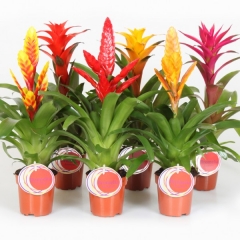





Vriesea is a kind of flower which consists of about 200 species, some of them being widespread as houseplants. Their leaves and blossoms are popular for their color and attraction.
Their beauty is due mostly to brightly colored bracts that appear in different periods of the year, but the flowers themselves are less significant and durable.

Cultivation
Rosette dies after the flowering of her mother plant, but is replaced by the offspring new base, which allows unhindered in the same pot. After 2-3 years they grow back. For their relocation, use a peat-based soil, with an addition of 1 / 4 sand. Cut at any time of the year when they begin to wilt rosettes at 2.5-5 cm from the base.
Spring and summer temperatures can reach even 27 degrees Celsius. Keep the plant in good light and expose it to sunlight for several hours a day (morning and evening).
Soak it in abundance, always keeping the central cavity filled with water and moist compost. Renew water in the cavity each month. Use rain water or boiled water with an addition of few drops of vinegar.
Pour a little liquid fertilizer in the central cavity diluted in water once every 3-4 weeks.
In autumn, you have to cut from the inflorescence when it dries. In winter, the temperature must not fall below 13 degrees Celsius. Expose plants to light, not in direct sun but in a ventilated environment, without the cold air flow and keep the compost moisturized by regular watering.
Reproduction
In March-April, take from basal shoots some height of 15 cm. They need to let the roots attached. Planted separately, using wet compost and small pots, 8 cm in diameter put it in a box at 24-27 degrees Celsius.
Expose them to light but not in direct sun for 4-6 weeks until the roots get back to life. Then you have to treat them as the mature plants. After a year, transfer them into pots with a diameter of 13 cm.
Hazards and precautions:
If before flowering leaves begin to lose their color and get a fragile look, increase the amount of water they manage, but avoid its stagnation in the tray because this could cause to the root rot.
Cold air currents can cause the same harm to the plant too.
Cochineal flour with a whisk or eliminate brush soaked in denatured alcohol.
Copyright © www.100flowers.win Botanic Garden All Rights Reserved